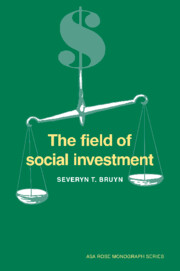Book contents
- Frontmatter
- Contents
- Preface
- Part I The idea of social investment
- 1 The meaning of social investment
- 2 The activity of social investment
- 3 A theory of social investment
- Part II Social criteria and research
- Part III Global social investment
- Epilogue: Social investment as a self-correcting movement in the market system
- Notes
- Bibliography
- Name index
- Subject index
- Title in the Series
1 - The meaning of social investment
Published online by Cambridge University Press: 19 January 2010
- Frontmatter
- Contents
- Preface
- Part I The idea of social investment
- 1 The meaning of social investment
- 2 The activity of social investment
- 3 A theory of social investment
- Part II Social criteria and research
- Part III Global social investment
- Epilogue: Social investment as a self-correcting movement in the market system
- Notes
- Bibliography
- Name index
- Subject index
- Title in the Series
Summary
We are accustomed in our society to the idea of making economic investments, but not to the idea of making social investments. Social investments introduce noneconomic criteria into investment decisions and thus change the order of business. Social investors are interested in the impact of their investment on people as well as in making a profit. They believe they can maintain economic returns on their capital while expressing a social concern about corporate conduct; that by investing only in socially responsible companies they can have an effect on corporate behavior; and that social criteria can provide incentives for business to function more reliably in the public interest. Other investors hold that social investments will help business become more self-regulating. Still others contend that investments should be directed toward the cultivation of social objectives within the economy. At a more theoretical level, we might say that they are all interested in social development while remaining steadfastly committed to economic development and financial returns on their investment. They all seek to encourage the development of social values within the free enterprise system.
The origins of the movement are hard to trace, but the use of social criteria became visible among large organizations in the 1960s during a period of urban unrest. In 1967 the Ford Foundation, stimulated by a concern already being expressed by church and university leaders, announced that social investments would become part of its philanthropic program. It hoped to increase the impact of its giving by making higher-risk, lower-return investments in minority businesses, housing, and conservation projects.
- Type
- Chapter
- Information
- The Field of Social Investment , pp. 1 - 15Publisher: Cambridge University PressPrint publication year: 1987

